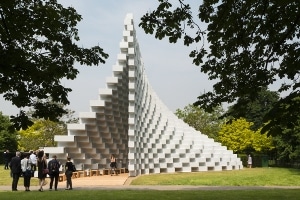Nov 24 2016
 Serpentine Pavilion 2016 designed by Bjarke Ingels Group (BIG); (10 June – 9 October) (Credit: Iwan Baan)
Serpentine Pavilion 2016 designed by Bjarke Ingels Group (BIG); (10 June – 9 October) (Credit: Iwan Baan)
Glass fiber reinforced polymers (GFRPs) are advanced composites that are stiff, light, durable, strong materials that can be shaped flexibly and used to build huge load-bearing structures. A new study, utilizing data logged from sensors on a GFRP structure at the 2016 Serpentine Architecture Programme held in London, has found that stresses can be observed from real advanced composite structures.
In a project led by Dr Wendel Sebastian, Reader in Structural Engineering in the Department of Civil Engineering at the University of Bristol, sensors were given throughout the Serpentine Pavilion. The Pavilion is an ‘unzipped wall’ which is a straight line at the top that transforms into a 3D curved construction lower down, and is built by Bjarke Ingels Group (BIG).
Data on the Pavilion structure’s response to gravity or self-weight and environmental (temperature and wind) loads were also collected as part of the project.
Architects find composites attractive, as these materials can be embedded with multi-functionality. The GFRP material used in the construction of the Serpentine Pavilion was both load-bearing and translucent, and influenced the decision to construct the structure from GFRP “boxes”.
The translucent exhibition building is 26 m long, 14 m high and more than 12 m wide. It has been designed for as many as 200 people. Thousands of sightseers have visited the structure throughout the summer.
Due to its advanced assembly and shape, the Pavilion exhibited a hybrid and complex structural response - as a frame as well as a dome - to applied loads. To ensure the reliability of the structure, safety factors were employed in its design. However, it was found that the real structural action of a structure can be understood by monitoring a real, as-built structure, which opens the doors for relatively smaller safety factors in the design of futuristic exhibition structures.
Advanced composites behave differently from traditional construction materials such as steel and concrete, so the improved understanding that we gain using data from a spectrum of real composite structures will help us use these materials even more creatively in the future.
Dr Wendel Sebastian, University of Bristol
Dr Sebastian worked with the contractor in charge of breaking the structure apart, which allowed him to log data that provided a better understanding of the stresses released by the structure at the time of dismantling. To overcome any lack-of-fit in between the boxes while assembling the structure, these stresses were locked into it from the beginning.
However, random differences from the tolerances mentioned in the engineering drawings mean that lack-of-fit stresses that are of special importance for structure constructed from slender members are also random, making them hard to predict.
The chance to explore these stresses with sensor data from a real structure has been a significant feature of the endeavor. These stresses generally remain a secret of the building. As the sensors were installed after the construction of the Pavilion, this rare chance to quantify these stresses – slightly modified over a period – using sensor data, has been made possible only because they were released by dismantling.
Dr Sebastian has also been using a GFRP traffic bridge employed on the road network near Bristol to gather sensor data. The bridge was a prefabricated, lightweight structure. A low-power crane was used to lift the bridge quickly into position, which enabled the early removal of a 7 km diversion essential during the bridgeworks.
The study will be presented at the 2017 Advanced Composites in Construction (ACIC) conference.